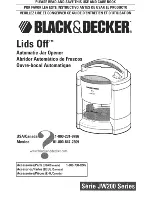
T
RIP
-T
EST
B
UTTON
See Figure 1 on page 1. The TRIP-TEST button, located center right on the circuit board, is a tool
to evaluate most of the control electronics and to help in setting the relay time.
Set the probe sensitivity potentiometer "B" to the halfway point (vertically). Push the trip-test button
on and off quickly. DO NOT hold the button on. The signal generated simulates that of a detected
vehicle. No response indicates component failure on the circuit board or failure of the power supply
or a shorted probe or cable. Disconnect probe wires from terminal strip and try again.
Special Note
: After using the TRIP TEST button to test the circuit board, wait at least ten seconds before
re-testing. This allows time for the re-trigger hold-off timer to reset.
R
E
-T
RIGGER
H
OLD
-O
FF
The re-trigger hold-off circuit allows both for a shorter annunciator time and minimizes irritating
multiple alarms. However, if you are working with an application not conducive to this re-trigger hold-
off feature, call
our
technical staff at
(800) 878-7829
for the disconnect procedure.
T
RANSIENT
S
UPPRESSION
The CT-2B control unit transient suppressor circuit is already connected. The transient suppressor
is activated when the wire is connected to terminal No. 4. This circuit will reduce false alarms caused
by lightning. If difficulty occurs when setting the probe sensitivity, disconnect the wire from terminal
No. 4 to de-activate the transient suppressor.
A
DJUSTING
S
OUNDER
(A
NNUNCIATOR
) T
IME
See Figure 1 on page 1. This function controls the amount of time the customer desires the
sounder(s) to stay on. It may be adjusted to stay on anywhere from 1/2 to 15 seconds. To adjust,
use the potentiometer "A" (CW to increase time). Push the trip-test button to hear your adjustment.
Keep adjusting until the desired time is achieved.
A
DJUSTING
P
ROBE
S
ENSITIVITY
See Figure 1 on page 1. Probe sensitivity is set at the factory and does not usually need to be
adjusted. Factory setting allows a single standard probe to cover a 12 foot wide driveway when
installed beside it (see "Installing CT-6 Probe and Cable" on page 4). Increasing the sensitivity
above the factory setting is not recommended unless the probe is located in a low sensitivity area.
When the probe is placed in the center of the drive, sensitivity may be decreased considerably
allowing the probe to be installed closer to highway traffic, power lines, etc.
To adjust probe sensitivity, turn the potentiometer "B" fully counter clockwise and adjust clockwise
in small increments. Use a small, slow moving vehicle to test sensitivity. Have it pass the probe and
adjust the potentiometer between each pass. Stop adjusting at the point where the small car trips
the system each time it passes the probe.
E
XTRA
S
ET
OF
R
ELAY
C
ONTACTS
See Figure 1 on page 1. The annunciator relay has a second set of free SPDT contacts that
connect to terminals No. 5, 6, and 7. The contacts may be used to trip a dialer, alarm panel, home
automation panel, and transmitter, etc.
C
ONNECTING
TO
A
G
ATE
O
PERATOR
See Figure 1 on page 1. The CT-2BG control unit can be used to trigger a gate operator by using
the free set of relay contacts #6 (Common) and #7 (Normally Open). These contacts should be
2





























